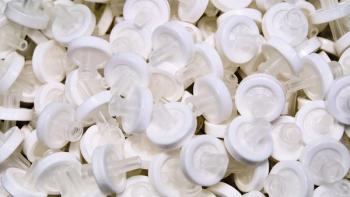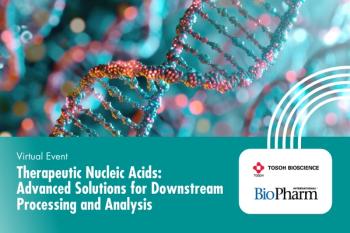
- BioPharm International-04-02-2011
- Volume 2011 Supplement
- Issue 3
Benefits of a Revised Approach to Anion Exchange Flow-Through Polish Chromatography
A high-performance anion exchange resin performs well compared with membranes. In addition, the resin offers greater flexibility and cost savings.
ABSTRACT
Anion exchange (AEX) products are commonly used as a polish step in product flow-through (FT) mode to bind impurities. Comparing resins with membranes and membranes to membranes is challenging due to the complicated and unique scale-down model formats of the products offered by different vendors. A novel approach to AEX FT using a short, 5 cm length, packed bed format with a faster operating flow rate is explained. The performance of commonly used AEX resins and membrane adsorbers, detailing dynamic binding capacity performance, efficiency, and a new disposable option for packed bed chromatography are compared. The data presented will show that a high performance AEX resin competes well with the performance of membranes. It provides similar processing times and the added benefits of reusability, ease of packing at different scales in various column formats, and the ability to implement initial process design from early phase manufacturing to commercial manufacturing, reducing overall costs and time to market.
AEX chromatography resins and membrane adsorbers are frequently used for downstream purification in the biotechnology industry. AEX products are used for polish chromatography in product FT mode to bind product-related and process impurities. Multiple product formats are commercially available, including chromatography resins, which are packed into chromatography columns, and membrane adsorbers, which are supplied in self-contained plastic housings. Comparing performance across product types and formats, including resins to membranes and membranes to membranes, is challenging due to the complicated and unique formats for scale-down models of the different product types.
In FT mode, membranes have shown advantages over traditional soft gel packed beds due to faster operating flow rates, reduced buffer requirements, and disposability. In most cases, traditional soft-gel FT columns are sized for the optimization of volumetric throughput to improve operating flow rate and decrease process bottlenecks, rather than sized for actual impurity binding capacity. This results in packed columns with larger diameter, and therefore volume, than optimal, and this improper column sizing results in greater resin requirements and increased buffer usage, both of which impact operating time and cost of goods. Although membranes may be simpler to implement for early phase manufacturing, where the process scale is typically smaller, these products are not always cost effective at the larger, late phase or commercial manufacturing scales due to high material costs and lack of reusability. In addition, the available product formats are limited, posing linear scale-up challenges, adding to the challenge of maintaining process continuity and proving process equivalence between scales. Late-phase process redesign or a complete switch to packed bed chromatography may be required due to high consumable costs or limited product formats not allowing for linear scale-up.
On the other hand, the re-use of resins is well established for traditional packed bed chromatography and this facilitates lower overall material costs. In addition, chromatography columns are easily scalable. Unit operations can be defined and locked for early phase manufacturing and then simply scaled up in a linear fashion as manufacturing scale increases reducing the need for later phase redesign. High performance, rigid resins with a higher volumetric throughput capability provide an advantage over soft-gel resins allowing for properly sized columns with smaller footprints similar to membranes. These rigid resins allow for convective flow through the bead, improving mass transfer and increasing efficiency at higher linear flow rates, thereby improving process productivity.
Figure 1: Pressure-flow curve for POROS HQ 50 in 8 cmD Go-Pure Pre-Packed column format at bed heights of 5 cm and 20 cm (5 um frits, 0.1 M NaCl, system pressure subtracted).
Demonstration of performance using a scale-down model
An alternative and beneficial approach to AEX FT is the use of a short, 5-cm length, packed bed format with a faster operating flow rate. This format enables volumetric throughput capability that is similar to the membrane format, and increases flexibility when designing a purification scheme. The scale-down model used to compare the performance of the different AEX products/formats is summarized in Table I. We evaluated five commonly used AEX products: three resins and two membrane adsorbers for dynamic binding capacity of DNA and protein using bovine serum albumin (BSA) to mimic common contaminants, such as host cell proteins, removed during a FT step. The resin target operating flow rate was the maximum flow rate defined per the manufacturer's operating instructions. The membrane target operating flow rate was based on the common industry design space of 10 membrane volumes (MV) per minute. Although POROS chromatography resins can be operated at 2000 cm/h or faster, 1000 cm/h was evaluated as the upper limit for this evaluation. A 5 cmL POROS column can be operated at 1000 cm/h with a low pressure drop allowing for the use of high operating flow rates in conventional low pressure chromatography columns and systems (see Figure 1).
Table I: Scale down approach for AEX chromatography resin and membrane adsorber comparison.
Materials and methods
DNA Dynamic Binding Capacity: The AEX product was pre-charged with 20 mM sodium phosphate, 1 M NaCl, pH 7.0 followed by an equilibration with 20 mM sodium phosphate, 50 mM NaCl, pH 7.0 (7.8 mS/cm). Each column/membrane was loaded with 2 mg/mL Herring Sperm DNA (Sigma D3159) in equilibration buffer (titrated to pH 7.0 with 0.2 M sodium phosphate dibasic, anhydrous) with a final conductivity of 8.8 mS/cm per the flow rates listed in Table I. Binding capacities at 5% (C5) and 50% (C50) breakthrough were determined based on UV absorbance.
Table II: DNA and BSA dynamic binding capacities of five AEX products.
BSA Dynamic Binding Capacity: The AEX product was pre-charged with 20 mM Tris, 1 M NaCl, pH 8.0 followed by an equilibration with 20 mM Tris, pH 8.0 (1.1 mS/cm). Each column/membrane was loaded with 10 mg/mL BSA (Sigma A7906, pI 4.7-5.3, MW 66 kDa) in equilibration buffer with a final conductivity of <2 mS/cm per the flow rates listed in Table I. C5 and C50 breakthrough were determined based on UV absorbance.
POROS HQ Viral Clearance: Polyclonal human IgG (Sigma G4386, MW:155–160 kDa; pI: ~6.9) was used for the model process. The salt concentrations evaluated and the corresponding conductivity values are summarized in Table III and Figure 2. The column format was 0.46 cmD x 5 cmL, 0.83 mL or 0.46 cmD x 20 cmL, 3.3 mL. Viral clearance was assessed at 1000 cm/hr at room temperature for the 25 mM, 50 mM and 150 mM runs and 300 cm/hr for the 100 mM NaCl run. The studies were all run at pH 7.0 using 20 mM bis-tris propane for buffering. The column was loaded with 5 mg/mL IgG with a 5% xenotropic murine leukemia virus (xMuLV, retrovirus, enveloped, ssRNA, 80-120 nm) or murine minute virus (MVM, parvovirus, non-enveloped, ssDNA, 18-26 nm). Spike and column FT samples were taken to determine viral clearance.
Results and discussion
The DNA and BSA binding capacity data of five anion exchangers is summarized in Table II. POROS HQ 50 demonstrated the highest DNA binding capacity of the five AEX products assessed. The C5/C50 ratio is a measure of the mass transfer capability of the resin/membrane and a way to characterize the efficiency of binding. The more efficient the mass transfer capability of a product, the less effect flow rate has on capacity. As the C5/C50 ratio approaches 1.0 the resin/membrane becomes more efficient. The POROS HQ C5/C50 ratio is as efficient as the membranes and significantly more efficient than Fractogel TMAE and Q Sepharose FF for DNA binding. The capacity at 5% breakthrough on the 5 cmL column at 1000 cm/hr was compared to the capacity on a 20 cmL column run at 300 cm/hr. POROS HQ had minimal change in performance in the two formats as compared to the other two resins. In addition, with POROS HQ, the DNA capacity is high under a wide range of operating conditions (30-35 mg/mL at pH 6.0–9.5 with 150 mM NaCl and >20 mg/mL at pH 7.0 with up to 400 mM NaCl, data not shown). POROS HQ ranked second highest for BSA C5 dynamic binding capacity and shows similar capacity and mass transfer efficiency similar to the membrane products.
Table III: Viral clearance on POROS HQ (1000 cm/hr, 5-cm bed height).
POROS HQ in FT mode demonstrated good viral clearance capability for XMuLV up to 150 mM NaCl (18 mS/cm) at pH 7.0, as summarized in Table III and Figure 2. The MVM model virus showed good clearance up to 50 mM NaCl (8 mS/cm) in this new AEX FT format suggesting that a shorter column run at a faster operational flow rate can achieve good viral and impurity clearance. The conductivity of the load appears to have an effect on both viruses. MVM is a poorly charged virus so minimal salt is needed to neutralize the charge and decrease the binding. However, it is a small virus and can easily access the pores, so binding performance is flow rate independent. XMuLV, on the other hand, is significantly larger and highly charged. With the higher salt (18 mS/cm), the hydrodynamic radius of the virus is most likely changing, allowing for more optimal perfusion into the bead.
Figure 2: Effect of load conductivity on viral clearance capability of POROS HQ.
Table IV presents a cost model comparing POROS HQ 50 in this short-bed format to a traditional resin and membrane process. The POROS HQ product load time in the new format is seven times faster than the traditional resin step and three times faster than the membrane. The total process time is six times faster than the traditional resin process and almost two times faster than the membrane. In addition, the optimized HQ format uses four times less buffer than the traditional resin step. One of the benefits of using a resin is the reusability at commerical scale, and POROS HQ allows for aggressive cleaning and sanitization, yielding excellent cycling and reuse performance. This study shows the cost difference for one cycle compared to 50 cycles and the cost benefit of reuse compared to a single-use membrane.
Table IV: Large scale operating cost model for POROS HQ versus conventional AEX resin (2700 L at 5 mg/mL, 13.5 kg monoclonal antibody process).
Conclusion
The novel approach of using a short, disk-like column with a resin capable of operating at high flow rates for AEX flow-through polish chromatography delivers increased flexibility when designing a purification scheme. This format is ideal for rigid resins with flow rate independent performance driven by the convective properties of the base bead. The properties of POROS HQ, for example, drive increased throughput and smaller column sizes, and ultimately a column that can be sized based on capacity for impurities. In addition, POROS HQ has been shown to have high impurity binding capacity and clearance over a range of process conditions, including high conductivity conditions (data not shown). This decreases the need for dilution of the feed stream or inclusion of a diafiltration step prior to loading on the HQ column, making the process more efficient and cost-effective. If disposability is a factor, Life Technologies now offers Go-Pure Pre-Packed Chromatography Columns for maximum convenience, providing faster time to process and faster time between processes.
This new approach to AEX FT polish chromatography increases process development flexibility and offers a more cost effective approach to this process step as compared to improperly, oversized soft gel columns, and membranes with limited sizes and expensive formats at larger scale. This study shows that a high performance AEX resin competes well with the performance of membranes, providing similar processing times and the added benefits of reusability, which decreases material costs with increased cycles as modeled in Table 4. In addition, ease of packing at different scales in various column formats and the ability to implement initial process design from early phase manufacturing to commercial manufacturing reduces overall process development costs and decreases time to market.
For Research Use Only. Not intended for animal or human therapeutic or diagnostic use.
Acknowledgments
The authors would like to thank Susanne Alexander, Roger Decker, and Elliot Haimes for assistance with the execution of these studies.
SHELLY COTE PARRA, MS, is a senior field applications scientist in the POROS Applications group at Life Technologies,
Articles in this issue
over 14 years ago
Innovation and the Art of Downstream Processingover 14 years ago
BioPharm International, April 2011 Supplement (PDF)Newsletter
Stay at the forefront of biopharmaceutical innovation—subscribe to BioPharm International for expert insights on drug development, manufacturing, compliance, and more.




